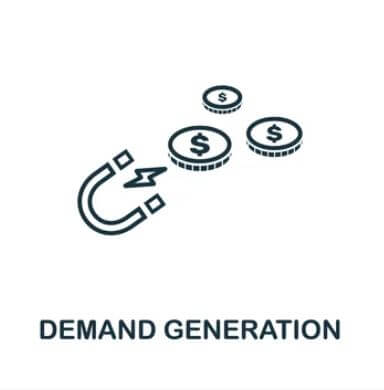Introduction to Demand Generation
Demand generation creates interest and desire for a product or service among potential customers to increase revenue and grow a business. It is a crucial aspect of any successful marketing strategy, as it helps companies identify and target the right audience, generate leads, and convert those leads into paying customers.
What is Demand Generation?
Demand generation creates and nurtures a relationship with potential customers by providing them with valuable information and resources, such as educational content and industry insights. This helps to establish trust and credibility leading to increased interest in a company’s products or services.
Importance of Demand Generation in Business
Demand generation is essential for businesses of all sizes and industries, as it helps to attract and retain customers, increase revenue, and drive growth. Companies can effectively reach and engage with their target audience by understanding the needs and pain points of potential customers and creating targeted marketing campaigns. This, in turn, leads to more qualified leads and higher conversion rates.
Demand generation also helps establish a company as a thought leader in their industry, building trust and credibility with potential customers. It also helps to differentiate a company from its competitors and create a unique brand identity.
In summary, demand generation is vital to any successful marketing strategy. By identifying and targeting the right audience, generating leads, and converting those leads into paying customers, companies can effectively attract and retain customers, increase revenue, and drive growth.
Understanding the Demand Generation Funnel
The demand generation funnel is a visualization of the different stages a potential customer goes through before becoming a paying customer. It is a valuable tool for understanding the customer journey and developing a targeted and effective demand-generation strategy. The stages of the demand generation funnel are:
Awareness
The awareness stage is the first stage of the demand generation funnel, where potential customers become aware of a company’s products or services. This is typically done through advertising, such as social media, search engine ads, or display ads. The goal of the awareness stage is to generate interest and make potential customers aware of the company’s offerings.
Interest
In the interest stage, potential customers have become aware of a company’s products or services and are actively seeking more information. This is typically done through content marketing, such as blog posts, videos, webinars, or whitepapers. The goal of the interest stage is to provide valuable information and resources that educate and engage potential customers and help them to understand the benefits of a company’s offerings.
Consideration
In the consideration stage, potential customers better understand a company’s products or services and are actively evaluating whether or not to make a purchase. This is typically done through lead nurturing, such as email campaigns, case studies, or free trials. The goal of the consideration stage is to build trust and credibility and to provide potential customers with the information they need to make an informed decision.
Conversion
In the conversion stage, potential customers have decided to purchase and become paying customers. This is typically done through lead scoring, lead nurturing, and remarketing efforts. The conversion stage aims to provide a seamless and easy buying process that makes it easy for potential customers to become paying customers.
Loyalty
In the loyalty stage, customers purchase and are satisfied with their experience. This is typically done through customer retention efforts such as loyalty programs, customer service, and after-sales support. The goal of the loyalty stage is to keep customers engaged and satisfied with the company’s products or services and to encourage repeat purchases and customer advocacy.
In summary, the demand generation funnel is valuable for understanding the customer journey and developing a targeted and effective demand generation strategy. By understanding the different funnel stages, companies can create targeted marketing campaigns that effectively move potential customers through the funnel and convert them into paying customers.
Tactics for Executing a Demand Generation Plan
Once a demand generation strategy has been developed, it’s time to execute and implement the plan. Many tactics can be used to implement a demand generation plan, including:
Paid Advertising
Paid advertising, such as Google AdWords or social media advertising, can be used to reach a large audience and generate leads quickly. These ads can target specific demographics, interests, and behaviors, making them a highly effective way to generate leads and increase brand awareness.
SEO and Content Marketing
SEO (Search Engine Optimization) and content marketing go hand in hand, as SEO is optimizing website content to rank higher in search engine results. This can be done by creating high-quality, informative, and engaging content that targets specific keywords and phrases and optimizing website structure and meta tags. Companies can attract potential customers and generate leads through organic search by creating valuable content relevant to their target audience.
Social Media Marketing
Social media platforms, such as Facebook, Twitter, LinkedIn, and Instagram, can be used to reach a large audience and generate leads. Companies can build a community around their brand and generate leads through social media by creating engaging and informative content and actively engaging with followers.
Email Marketing
Email marketing is a highly effective way to nurture leads and convert them into paying customers. By creating targeted email campaigns that provide valuable information and resources, companies can engage with potential customers, build trust and credibility, and convert leads into paying customers.
Influencer Marketing
Influencer marketing is a tactic that involves partnering with individuals who have a large following on social media or other platforms. These individuals, known as influencers, can promote a company’s products or services to their followers, increasing brand awareness and generating leads.
Event Marketing
Event marketing involves hosting or participating in events, such as trade shows, conferences, or webinars, to generate leads and increase brand awareness. Companies can connect with potential customers, demonstrate their expertise, and generate leads by participating in these events.
In summary, executing a demand generation plan involves using a variety of tactics to reach and engage with potential customers, generate leads, and convert those leads into paying customers. These tactics include paid advertising, SEO and content marketing, social media marketing, email marketing, influencer marketing, and event marketing.
It’s worth noting that different tactics may work better or worse depending on the type of business or product/service you have, so it’s essential to test other options and measure their effectiveness using analytics and metrics.
Measuring and Optimizing Demand Generation Efforts
Measuring and optimizing demand generation efforts is crucial for understanding what is working and isn’t and making data-driven decisions to improve results. Some key metrics and best practices for measuring and optimizing demand generation efforts include:
Lead Generation Metrics
Lead generation metrics, such as lead-to-customer conversion rate and cost per lead, are essential for understanding the effectiveness of demand generation efforts. By tracking these metrics, companies can identify which tactics generate the most information and optimize their actions accordingly.
Engagement Metrics
Engagement metrics, such as website traffic, social media engagement, and email open rates, are essential for understanding how potential customers interact with a company’s brand. By tracking these metrics, companies can identify which tactics drive the most engagement and optimize their efforts accordingly.
Revenue Metrics
Revenue metrics, such as customer lifetime value and acquisition cost, are essential for understanding the financial impact of demand generation efforts. By tracking these metrics, companies can identify which tactics generate the most revenue and optimize their actions accordingly.
A/B Testing
A/B testing tests two or more versions of a marketing asset, such as a landing page or email, to determine which version performs best. By A/B testing different versions of marketing assets, companies can optimize their demand generation efforts and improve results.
Personalization
Personalization is tailoring marketing efforts to specific segments of the target audience. By personalizing marketing efforts, companies can improve engagement and conversion rates and reach their target audience better.
Continuous Improvement
Continuous improvement regularly reviews and optimizes demand-generation efforts based on data and feedback. By continuously improving demand generation efforts, companies can stay ahead of the competition and achieve better results.
Conclusion
In summary, measuring and optimizing demand generation efforts is crucial for understanding what works and isn’t and making data-driven decisions to improve results. Key metrics to track include lead generation, engagement, and revenue metrics, while best practices include A/B testing, personalization, and continuous improvement. By regularly reviewing and optimizing demand generation efforts based on data and feedback
In conclusion, demand generation is a crucial element of any business strategy, as it helps companies to attract and convert potential customers into paying customers. By understanding the demand generation funnel, developing a targeted and effective demand generation strategy, executing a plan using various tactics, and measuring and optimizing efforts, companies can improve results and achieve better ROI. However, the demand generation process is ongoing and requires continuous monitoring, testing, and improvement.
The following steps for companies looking to improve their demand generation efforts would be:
- Continuously review and analyze their current demand generation strategy and tactics
- Track key metrics, such as lead generation, engagement, and revenue metrics, to identify areas for improvement
- Optimize efforts based on data and feedback to improve results
- Continuously test and implement new tactics and strategies to stay ahead of the competition
- Invest in technology and tools that help to automate and streamline demand generation efforts.
It’s also essential for companies to focus on building relationships and nurturing leads to convert them into long-term customers. This can be achieved through various tactics such as email marketing, personalization, and account-based marketing.
To be successful in today’s fast-paced business environment, it’s essential for companies to continuously monitor, analyze and optimize their demand generation efforts. Companies can achieve sustainable growth and improve ROI by taking a data-driven approach and focusing on building long-term relationships with customers.
F.A.Q
What is a demand generation example?
An example of demand generation would be a company creating and executing a comprehensive marketing campaign to increase awareness of its product or service and generate new leads. This campaign could include tactics such as paid advertising on social media, search engine optimization, content marketing, email marketing, influencer marketing, and hosting events or webinars. The campaign’s goal would be to attract and engage potential customers and convert them into paying customers. The company would then track critical metrics such as lead generation, engagement, and revenue to measure the campaign’s success and make data-driven decisions to optimize and improve its demand generation efforts.
What is B2B demand generation?
B2B demand generation refers to creating and nurturing interest in a product or service among potential business customers. This process typically includes a range of marketing tactics and activities to attract and convert leads into paying customers.
Some common B2B demand generation tactics include:
- Content Marketing: Developing and distributing valuable and informative content such as blog posts, whitepapers, e-books, webinars, and case studies to attract and engage potential customers.
- SEO: Optimizing a company’s website and online content to increase visibility in search engine results pages (SERPs) and drive more traffic to the site.
- Email Marketing: Sending targeted and personalized email campaigns to potential customers to nurture leads and drive conversions.
- Lead Nurturing: Building relationships with potential customers through targeted and personalized communications, such as email or direct mail campaigns.
- Account-Based Marketing: Tailoring marketing efforts to specific target accounts and decision-makers within those accounts to generate more qualified leads and close deals faster
- Event marketing: Participating in industry events, conferences, and trade shows to generate leads, build brand awareness and establish thought leadership.
B2B demand generation is a complex process that requires a comprehensive and ongoing approach. Companies must continuously monitor, analyze, and optimize their demand generation efforts to be successful.
What is the difference between demand generation and lead generation?
Demand generation and lead generation are related but distinct concepts in marketing.
Demand generation refers to creating and nurturing potential customers’ interest in a product or service. This process typically includes a range of marketing tactics and activities to attract and convert leads into paying customers. The main goal of demand generation is to increase the overall demand for a product or service.
Lead generation, on the other hand, refers to identifying and qualifying potential customers for a product or service. This process typically includes lead capture forms, email campaigns, webinars, and other tactics to gather contact information and basic information about potential customers. Lead generation aims to create a pool of qualified leads that can be nurtured and converted into paying customers.
In summary, demand generation is a broader strategy that involves a wide range of tactics to generate interest and create demand for a product or service. In contrast, lead generation is a specific tactic that focuses on identifying and qualifying potential customers. Lead generation is a part of demand generation, but not all demand generation activities are lead generation.
Why Is Demand Generation Important?
Demand generation is essential for several reasons, including:
- Business Growth: By attracting and converting potential customers into paying customers, demand generation helps companies to grow their customer base and increase revenue.
- Brand awareness: By executing a comprehensive demand generation strategy, a company can increase awareness of its brand, products, and services, leading to improved customer loyalty and increased sales.
- Competitive advantage: By staying ahead of the competition in terms of attracting and converting leads, companies can gain a competitive advantage and increase their market share.
- Cost-effective: By continuously testing and optimizing demand generation efforts, companies can achieve better ROI and improve the effectiveness of their marketing spend.
- Building long-term relationships: By focusing on lead nurturing and building relationships with potential customers, companies can convert leads into long-term customers.
- Improving customer retention: Companies can increase customer loyalty and retention by continuously engaging with customers through demand-generation efforts.
- Identifying new revenue opportunities: By continuously monitoring and analyzing demand generation efforts, companies can identify new revenue opportunities and expand their product or service offerings.
Demand generation is essential for sustainable growth and success in today’s competitive business environment.







